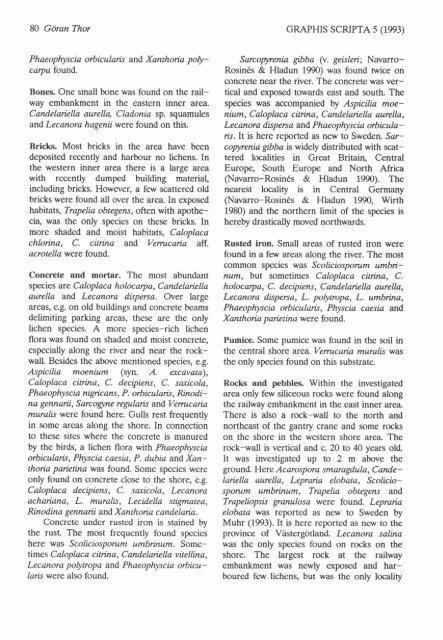GRAPHIS SCNIPTA - Universitetet i Oslo
GRAPHIS SCNIPTA - Universitetet i Oslo
GRAPHIS SCNIPTA - Universitetet i Oslo
You also want an ePaper? Increase the reach of your titles
YUMPU automatically turns print PDFs into web optimized ePapers that Google loves.
80 Goran Thor<br />
GRAPHTS SCRTPTA 5 (1993)<br />
Phaeophyscia orbicularis and Xanthoria potycarpa<br />
found.<br />
Bones. One small bone was found on the railway<br />
embankment in the eastern inner area.<br />
Candelariella aurella, Cladonin sp. squamules<br />
and Lecanora hagenu were found on this.<br />
Bricks. Most bricks in the area have been<br />
deposited recently and harbour no lichens. In<br />
the western inner area there is a large area<br />
with recently dumped building material,<br />
including bricks. However, a few scattered old<br />
bricks were found all over the area. In exposed<br />
habitats, Trapelia obtegens, often with apothecia,<br />
was the only species on these bricks. In<br />
more shaded and moist habitats, Caloplaca<br />
chloina, C. citrina and Vemtcaria aff.<br />
acrotella were found.<br />
Concrete and mortar. The most abundant<br />
species are Caloplaca holocarpa, Candelaiella<br />
aurella and Lecanora dispersa. Over large<br />
areas, e.g. on old buildings and concrete beams<br />
delimiting parking areas, these are the only<br />
lichen species. A more species-rich lichen<br />
flora was found on shaded and moist concrete,<br />
especially along the river and near the rockwall.<br />
Besides the above mentioned species, e.g.<br />
Aspicilia moenium (syn. A. excavata),<br />
Caloplaca citrina, C. decipiens, C. saxicola,<br />
Phaeophyscia nigicans, P. orbicularis, Rinodina<br />
gennaii, Sarcogtne regulans and Vemtcaria<br />
muralis were found here. Gulls rest frequently<br />
in some areas along the shore. In connection<br />
to these sites where the concrete is manured<br />
by the birds, a lichen flora with Phaeophyscia<br />
orbicularis, Physcia caesia, P. dubia and Xanthoria<br />
parietind was found. Some species were<br />
only found on concrete close to the shore, e.g.<br />
Caloplaca decipiens, C. saxicola, Lecanora<br />
achaiana, L. muralis, Lecidella stigmatea,<br />
Rinodina gennaii and Xanthoia candelaria.<br />
Concrete under rusted iron is stained by<br />
the rust. The most frequently found species<br />
here was Scoliciosporum umbrinum. Sometimes<br />
Caloplaca citina, Candelariella vitellina,<br />
Lecanora polytropa and Phaeophyscia orbicularis<br />
were also found.<br />
Sarcopyrenia gibba (v. geisleri; Navarro-<br />
Rosinds & Hladun 1990) was found twice on<br />
concrete near the river. The concrete was vertical<br />
and exposed towards east and south. The<br />
species was accompanied by Aspicilia moenium,<br />
Caloplaca citrina, Candelariclla aurella,<br />
Lecanora dispersa and Phaeophyscia orbicularu.<br />
It is here reported as new to Sweden. Sarcoryrenia<br />
gibba is widely distributed with scattered<br />
localities in Great Britain, Central<br />
Europe, South Europe and North Africa<br />
(Navarro-Rosin€s & Hladun 1990). The<br />
nearest locality is in Central Germany<br />
(Navarro-Rosinds & Hladun 1990, Wirth<br />
1980) and the northern limit of the species is<br />
hereby drastically moved northwards.<br />
Rusted iron. Small areas of rusted iron were<br />
found in a few areas along the river. The most<br />
common species was Scoliciosporum umbrinum,<br />
but sometimes Caloplaca citrina, C.<br />
holocarpa, C. decipicns, Candelariclla aurella,<br />
Lecanora diipersa, L. polytropa, L. umbrina,<br />
Phaeophyscin orbicularis, Physcia caesia and<br />
Xanthorin parictina were found.<br />
Pumice. Some pumice was found in the soil in<br />
the central shore area. Vemtcaria muralis was<br />
the only species found on this substrate.<br />
Rocks and pebbles Within the investigated<br />
area only few siliceous rocks were found along<br />
the railway embankment in the east inner area<br />
There is also a rock-wall to the north and<br />
northeast of the gantry crane and some rocks<br />
on the shore in the western shore area. The<br />
rock-wall is vertical and c. 20 to 40 years old.<br />
It was investigated up to 2 m above the<br />
ground. Here Acarospora smaragdula, Cande-'<br />
laiella aurella, Lepraria elobata, Scoliciosporum<br />
umbrinum, Trapelia obtegens and<br />
Trapeliopsis granulosa were found. Lepraria<br />
elobata was reported as new to Sweden by<br />
Muhr (1993). It is here reported as new to the<br />
province of Vtisterg6tland. Lecanora salina<br />
was the only species found on rocks on the<br />
shore. The largest rock at the railway<br />
embankment was newly exposed and harboured<br />
few lichens, but was the only locality
















